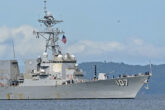
July 25, 2017
Dr. Jerry Hendrix before the Senate Committee on Armed Services Subcommittee on Seapower
Chairman Wicker, Senator Hirono, and distinguished members of the Seapower Subcommittee, thank you for extending the honor of addressing the topic of how the Navy might reach its stated requirement of 355 ships as quickly, economically and efficiently as possible.
Today I will present a series of options that many people, to include my friend and frequent co‐author Robert O’Brien, have suggested as providing ready paths to 355 ships. It is important to note that none of the ideas that follow are radical and that each of them has been used in the past, to include most recently during the Reagan administration’s campaign to bring the Cold War to a successful conclusion.
First it is important to note that the numbers three hundred and fifty, first proposed by President Trump in Philadelphia on 7 September 2016, and three hundred and fifty five, as enunciated by the Navy on 14 December of last year, are not arbitrary, but rather represent the minimum number of ships required to provide persistent presence in the eighteen maritime regions of the world (North Atlantic, Caribbean, South Atlantic, Gulf of Guinea, Arctic, Baltic Sea, Western Mediterranean, Eastern Mediterranean, Black Sea, Red Sea, Gulf of Oman, Arabian Gulf, Indian Ocean, South China Sea, East China Sea, Northern Pacific Basin, South West Pacific, South East Pacific), as identified by Combatant Commanders, where the United States has strong national interests. I must add that increasingly we must consider the Arctic as a region where we have increasing interests and plan additions to our fleet architecture accordingly. We must remember that in March of 2014, former Chief of Naval Operations, Admiral Jonathan Greenert stated before the House Armed Services Committee that to fully meet CoCom requirements would take a Navy comprised of 450 ships. Based upon current maintenance‐training‐deployment rotational models as well as the distances associated with these regions, the number of 355 ships has been determined to be the minimum number required to meet Combatant Commander demands with no room to spare.
Second, it is just as important to note that the time frame associated with the build‐up to 355 ships is equal in consequence as the raw number itself. Both China and Russia have taken advantage of the United States’ recent strategic focus on counter‐terrorism campaigns in Afghanistan and Iraq to take challenging profiles on the high seas. Russia has invested in a new generation of highly capable platforms, such as the new Yasen class fast attack submarine, and China is pursuing a maritime strategy that combines outright territorial acquisition with a rapid expansion and modernization of its fleet.
The full testimony is available online.
More from CNAS
-
The Venezuela Blockade
Roxanna Vigil, Council on Foreign Relations International Affairs Fellow, talks about President Donald Trump's order to blockade sanctioned oil tankers in Venezuela, and the r...
By Becca Wasser
-
The Astronomical Cost of Defeating ‘Any Foreign Aerial Attack’
Building Trump’s proposed missile and air defense system would be an enormous task — and the president’s spending target is likely just a fraction of the final price. CNAS adj...
By Becca Wasser
-
Defense / Transatlantic Security
When Defense Becomes Destruction: Austria-Hungary’s Mistake and Ukraine’s RiskThis article was originally posted on War on the Rocks. The southeastern Polish city of Przemyśl, with its elegant 19th century Habsburg-era train station, remains one of the ...
By Franz-Stefan Gady
-
Defense / Transatlantic Security
Ukraine’s Catch-22 MomentThis article was originally published in the Financial Times. In Joseph Heller’s wartime classic, Catch-22, the protagonist Yossarian seeks out the US army surgeon Doc Daneeka...
By Franz-Stefan Gady




